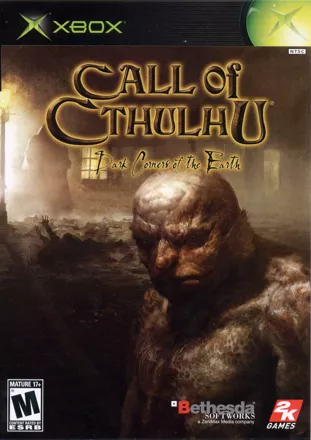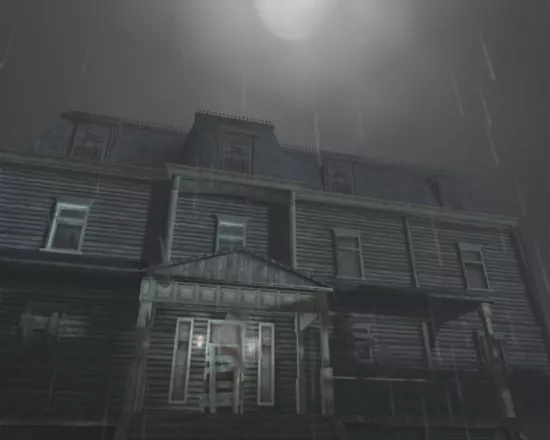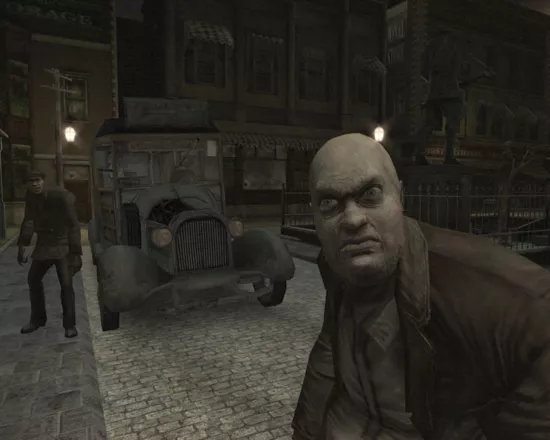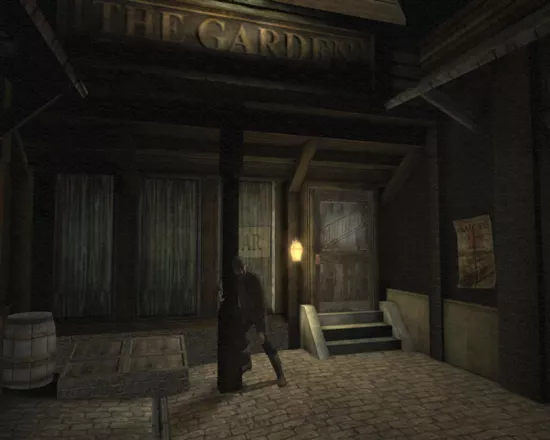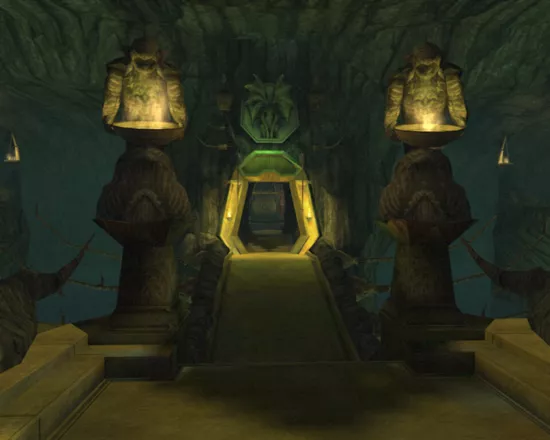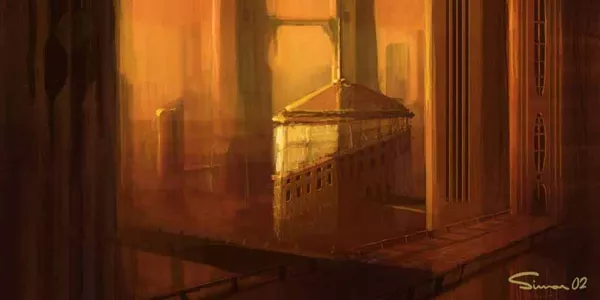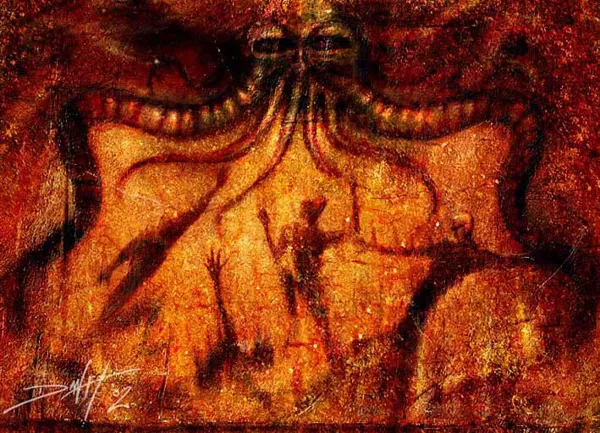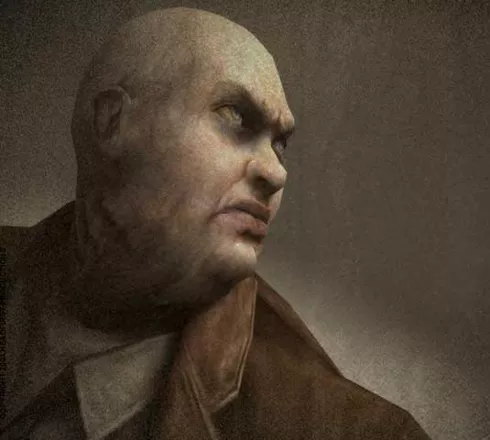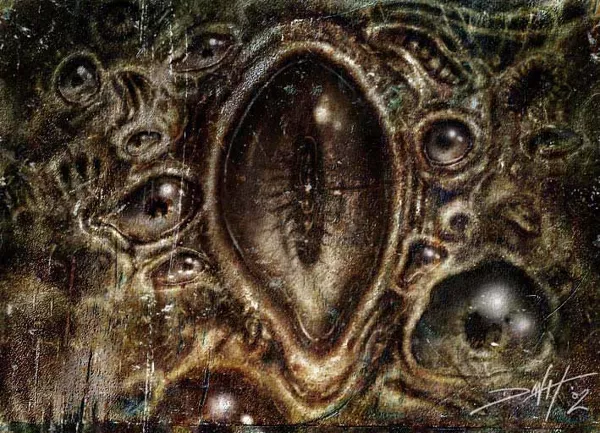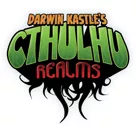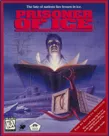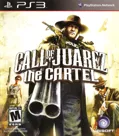Call of Cthulhu: Dark Corners of the Earth
Description official descriptions
Detective Jack Walters arrived in Innsmouth to solve a case of a missing person. But soon he finds himself confronted with terrible mysteries older than humanity, and with ghosts of the mysterious events that led to his incarceration in a mental hospital years ago.
Call of Cthulhu: Dark Corners of the Earth is a first-person action-adventure survival horror game, based on the H.P. Lovecraft mythos and his short story "The Shadow Over Innsmouth".
Initially, CoC: DCotE plays like an adventure game, but soon it gains elements of a stealth game and of a first-person shooter. Notably, the game does not feature an on-screen HUD (not even a crosshair); Jack's health is hinted at by visual cues; as for ammo, you need to remember how much you have left before you'll have to reload.
The health system used in the game is uncommon. There is no "hit points" system; rather, Jack receives minor or major wounds in specific parts of the body, and if he breaks a leg he's slowed down. To heal himself and prevent death from bleeding out, Jack can pick up medikits which contain bandages, splints, sutures and antidotes, each of which is used to heal a specific type of wound. Ill effects emerging from the wounds can be temporarily suppressed with a fix of morphine.
Jack's sanity also plays an important role. When Jack looks at disturbing things or finds himself in alarming conditions, his vision blurs, he begins hearing voices and talking to himself. If this gets too bad, Jack may go insane or commit suicide. Also, Jack suffers from acrophobia, and looking down in high places will cause him vertigo.
Spellings
- 邪神的呼唤:地球黑暗角落 - Chinese spelling (simplified)
Groups +
Screenshots
Promos
Credits (Xbox version)
94 People (91 developers, 3 thanks) · View all
| Producer | |
| Lead Designer | |
| Lead Engineer | |
| Lead Technical Artist | |
| Lead Creative Artist | |
| Lead Animator | |
| Senior Engineers | |
| Engineers | |
| Additional Design & Level Scripters | |
| Technical Art | |
| Background Art | |
| [ full credits ] | |
Reviews
Critics
Average score: 77% (based on 57 ratings)
Players
Average score: 3.8 out of 5 (based on 73 ratings with 7 reviews)
A fantastic game, if not broken to the point of being almost unplayable.
The Good
Before I started playing Call of Cthulu I had no idea what the big deal was with H.P Lovecraft. I had never read any of his stories or watched any of the poorly made college films based on his source material. Part of the reason I avoided his work was because it was a popular thing for "alternative" teenagers and to a lesser extent, adults, to latch onto. They would look at you with disgust if you didn't know who Lovecraft was, yet they knew little about the mythology beyond reading one of his short stories in between writing bad poetry.
There are also those who genuinely love Lovecraft's work and appreciate how instrumental he was in horror becoming mainstream.
Headfirst seemed to come from that second camp. They appreciated his work, resolved to treat it with respect and ended up creating a fine game. They were not pretentious though, the game doesn't rely on you having scrutinized Lovecraft's entire body of work. Call of Cthulu is a license done right, and to see this happen always gives me a warm feeling.
A large portion of Call of Cthulu is based on a pen and paper RPG. You play a private investigator who, after losing some of his life to period of darkness, resolves to take on a missing persons case. He travels to the town of Innsmouth and after some investigating is almost killed by the inhabitants. The rest of Dark Corners of the Earth is centered around his journey to discover what happened to himself and what happened to Innsmouth.
The artistic direction in Dark Corners of the Earth is to be applauded. Innsmouth itself is moody, faces peer out of windows and doors close as Jack walks past. The inhabitants are twisted and loathsome, watching Jack with suspicious eyes as he walks past. It's all definitely scripted, but it adds a degree of depth to the atmosphere that is missing in many survival horror games.
Because in the end, above all else, Dark Corners of the Earth feels like a survival horror game.
The gameplay is a combination of FPS action and stealth elements with a degree of investigative puzzle solving thrown in here and there. Jack relies on fire arms and more silent bladed weapons to fight the various twisted inhabitants of Innsmouth however most of the time it is better to avoid fights whatsoever. If Jack is injured instead of the standard "health kit" items the player must apply certain treatments specific to the injury sustained. For instance if his leg is injured it must be splinted, if it isn't he will hobble and his jumping will be compromised until the injury is taken care of. The gameplay in general is fantastic, Jack controls flawlessly and sneaks and jumps intuitively. Firing weapons relies on a steady hand and in a refreshingly realistic dynamic enemies can be killed with a single well placed knife thrust instead of requiring a barrage of slashes.
The variety of environments is remarkable and Headfirst seems to have mastered the art of backtracking. In many games, backtracking is employed as either a way of extending the length of a game or artificially convoluting puzzles. Backtracking in Dark Corners of the Earth feels natural and how it is employed here relies on you keeping your wits about you and watching for things that could potentially be useful later on. It isn't simply "I need to go back down 8 hallways to use red key on red door" it is more "I walked past a broken valve a little while ago, maybe I can use this valve handle there?"
The environments look good as well, which is a blessing. Each crumbling building sits with moody light being cast on it from a dirty bulb. Most characters look good, some don't, typically they do though. The weapon models contain decent enough detail and environmental effects like heat haze in the refinery and chill air linger around Jack as he explores.
The sanity mechanic introduced in the game transcends the foundation laid by Eternal Darkness as a launch title for the Gamecube. In Eternal Darkness your sanity was drained when enemies were nearby and if your sanity ran out the game would simulate odd things happening to either your character or your television set itself.
In Dark Corners of the Earth your sanity doesn't break the fourth wall, it is there to make you want to keep Jack alive. If you don't keep him away from corpses, odd sculptures of things Cthulu can channel the screen will blur and Jacks world will warp and deform. If his sanity drops too low he will take his own life either by beating himself to death or shooting himself.
The Bad
Dark Corners of the Earth shines in its opening moments. The chilling cinematic nature of these, the feeling that you're simply part of something much bigger and grander is lost as you progress through the game and it becomes essentially nothing more than a corridor shooter. There is little technique in how you play beyond repeatedly using trial and error to either tediously log a mental path for yourself or risk jumping out guns blazing to face hordes of respawning enemies.
O.k, say that's a bit of an exaggeration. This game never turns into a twitch shooter, but it also doesn't do a good enough job of keeping its fires stoked to consistently scare and intimidate you.
When you've come to terms with what the game demands of you you begin to realize that you don't get enough healing items to compensate for the vast amount hits you will take from enemies when you are forced to engage in combat. They are insanely overpowered and can take a lot punishment, while you can only take a few hits before being rendered critical. Additionally, if you take too much damage to one particular body part you will find yourself consistently running out of that one item you need to heal it.
The monotony of environments begins to take its toll after a while as well. I don't know whether or not it's simply because I can't stand dank, boring tunnels and generic stone temples but past Innsmouth the environments lack character or anything interesting for that matter. The dynamic, claustrophobic nature of Innsmouth contrasts greatly against generic mansion A and generic industrial building B.
What didn't I like about the game? The engine. The engine is one of the most unrefined and bug riddled ones I have ever encountered. Whether it was dropping frames or stopping the game from advancing there were so many occasions where something potentially game breaking happened that I almost lost count. I got stuck on ladders, stuck behind ladders, stuck in a vent, the ship scene wouldn't end, enemies wouldn't stop respawning when they were supposed to, events wouldn't trigger etc. etc.
It wasn't just one or two things, it was just an endless procession of bugs and glitches that ruined any suspension of disbelief that I had built up. I mean, I have never had to start a game from scratch because of a fault left in by the developer but I had to do it twice with Dark Corners of the Earth. Frankly, I'm embarrassed for Bethesda having released such an unfinished game.
The Bottom Line
Dark Corners of the Earth is a compelling game full of frightening elements that consistently surprise the player. The sanity system is pure genius and the driving, cinematic nature of the opening moments is simply nail biting. The gameplay is solid and the combat is violent and visceral. Having to heal your limbs independently from one another is, at first, a cool concept and the rendering of environments is beyond reproach.
It's a shame then that the game becomes a boring slog during the second half that displays none of the creative flair that the beginning of the game exhibits. The health system becomes a problem when you come up against waves and waves of ridiculously respawning enemies and the sheer glut of game breaking bugs that riddle the package are inexcusable.
While I enjoyed the presentation of the mythology and the gameplay when it worked, Dark Corners of the Earth becomes a tad too mediocre and broken to recommend.
Xbox · by AkibaTechno (238) · 2010
The Good
The idea of an adventure inside Lovecraft's universe is always appealing especially to those of us who play games loosely based on horror novels like Alone in The Dark, Realms of the Haunting and Clive Barker’s Undying.
Call of Cthulhu was in development for quite some time and the game shows why. The graphics and music are great; you can see there was a lot of detail to create great looking places and effects rarely seen in other games. The story is well written and if you have enough patience to proceed throw the game the cinematics will make an excellent job disclosing the plot.
The Bad
Call of Cthulhu has a lot of problems, the most important is that as an adventure is poor and you almost have no interaction with the environment, apart from pulling levers or switches. As a first person shooter is slow paced and boring the developers had a great idea to mix the different genres but they failed and the result is a bad hybrid.
Other problems in the game are: You can’t run, you either crawl or walk, this is very frustrating since the first levels of the game you don’t have weapons and you need to run for your life (Wait to be avoiding shotgun fire from five different enemies and you’ll know what it means to become a human target). Perhaps that’s why the IA has such poor aiming skills they sometimes miss when you stand still in front of them and sometimes they can hit you from far away. The game has a very innovative system where the player can suffer sanity looses when he is exposed to corpses or terrifying images, that is a great idea but the problem is that you can’t avoid most of them. Finally the player suffers from panic attacks that blur your screen so much you probably be dead by the end of them and also has vertigo which is a terrible thing that forces you to look up when jumping.
The Bottom Line
If you have a lot of patience (and I mean a lot) you might be able to forget the issues the game has and enjoy cthulhu for a while but I regret this is a game you won’t be playing ever again after you complete it, because when you close the story the large amount of problems cthulhu has as a game, will keep you from re-installing it.
Windows · by Shin_Akuma (15) · 2006
One of a kind; deeply innovative; scary as hell.
The Good
I'm scrambling along the wall of a warehouse while the yokels inside are blasting away blindly, shooting out the windows above my head and showering me with glass. Diving into cover and applying bandages to stop the bleeding from grazing shotgun pellets. Miraculously, none of my bones were broken after jumping off the loading ramp and out the window.
I am Jack Walters, and I really feel like all of Innsmouth wants me dead.
Of course, I know it's all in vain, ultimately: I've seen Jack die, hanging himself in an insane asylum some time from now. But yet I want to find out how it came to be, to see it through to the end. And that pretty much sums up how Dark Corners of the Earth does a better job than practically any other Lovecraft-themed derivatives at being Lovecraftian — there really is a feeling of being powerless, naked and afraid in the face of unspeakable horrors, and yet crawling along as best you can.
The thing that emphasizes this nakedness the most is the HUD: there isn't one. In fact, this game makes the very notion of a heads-up display seem downright ridiculous, like a remnant of 80's arcade machines. Instead of cute little icons telling you that You Have Activated Sneak Mode, the visual field broadens to give the impression of heightened wariness: when you're near death from blood loss, color drains from the world.
The game consistently never mentions 'hit points', only blood loss. If you caught the early marketing hype, you may have been given the impression that the simulationism went one step too far, with your character being able to catch pneumonia. That didn't make the final cut, probably for the better. Instead, the game implements localized damage to the head, torso, arms and legs. Locations can suffer heavy or light bleeding, poisoning, or broken limbs; different wounds require different medical treatments. This has tactical implications, as for example heavy bleeding requires the short-in-supply sutures, deterring you from getting too close to shotgun wielders. (To make sure the game is still playable, Jack has the metabolism of a hummingbird; he'll heal within a minute if all wounds have been treated, however untreated poisoning will kill him within four.)
It's also true to the Call of Cthulhu tabletop roleplaying system in that fighting is fast and deadly. Don't expect your "circle-strafing" skills to be much use, you need to concentrate on shooting abominations in the head before they can reload. That is, if you have a gun.
...you don't have a gun. You were, after all, just going to a quiet backwater fishing village to investigate a missing grocery store clerk. And no, there aren't guns just lying around for you to pick up. Those things are dangerous. What do you think this is, some sort of game? Nor are you in possession of Garrett's ability to magically fade into the shadows; you're just a private dick caught unaware.
See, calling this game "survival horror" gives people the entirely wrong impression: it's come to denote a very particular style of gameplay, to the point where a game like Disaster Report, which is not a horror game, gets called "survival horror." That's not Dark Corners of the Earth; it's inventive to the point of practically being a genre of one. There really is little today that resembles it — the easiest comparison would probably be to Alone in the Dark of 14 years past, and that is again largely because of the general feeling of style and genuine frights.
This style is evident from the very beginning of the game: when the first cutscene ends, you may not realize it, the transition is so subtle. Walking along, you can sense Jack's footsteps. No, not "head bob," his footsteps. Go into the house and in the door on your left. Peer into the darkness. "It's too dark to see anything, but from the rotting smell, it's probably a food store," Jack tells you. Outstanding. There should be (darkened) demo booths of that intro sequence, it'd probably make it up in shifted units.
All of this inventiveness goes towards lending the game gravity, making you forget that you're playing a game. You know, immersion. That thing games are supposed to be all about. This holds true to such a degree that at one point, going back to try and make it through a section with more medical supplies felt like I was violating the story. It happened that I had been scoping out an area and just happened to look up, and— well, that would be spoiling it. Suffice to say, things that would just be "look, scary thing" in a less inspired game are lovingly crafted in Dark Corners to sneak up on you when you least expect it.
Oh, and the music: you don't notice it. You only notice what it does to you. It's brilliant.
The Bad
This game is meant to be played in the dark, and they mean it. Fiddling with the brightness will give you a genuine feeling, when appropriate, of stumbling about in a darkness where things are vaguely sensed rather than seen. This also means that you simply can't play during the day.
Looking at the minimum specs, you might think this game was outdated long ago; that's more of an artifact of the game's long development history, but yes, the graphics are a bit two-years-ago. However, it puts newer graphics cards to work on dynamic lightning, subtle visual enhancement and the effects that give the impression of being groggy when you've just woken up, queasy when in a room with a corpse, scared out of your wits or high on morphine.
There's little point in running the game at higher resolutions than 800x600; you're better advised to spend the horsepower on antialiasing instead. The thing is, and I realize this is a cliché, it moves beautifully. I could spend all day, or rather all night, looking at that old geezer in the poorhouse as he gazes out the window. Half-Life 2 might have super-detailomatic ReActor(tm) technology or whatever; in Dark Corners of the Earth you're talking to people—really talking with them—who are brought to life within the story.
Okay. In all honesty, there is one thing that detracts from the game later on: dead bodies simply fade into the air. If there was one thing about the game I could change, that would be first on the list.
The Bottom Line
Look a couple of paragraphs above. "Queasy when in a room with a corpse." Have you seen that in any other game? Is there anywhere else you've played a character with enough humanity to actually be a bit dizzy in the face of death?
You need to play Dark Corners to see that a game can do things previously unthought of. And you need to play Dark Corners to be Jack Walters, scurrying along the streets and rooftops of Innsmouth, trying desperately to stay alive.
Windows · by Ola Sverre Bauge (237) · 2006
Trivia
Details
When playing Call of Cthulhu: Dark Corners of the Earth pay close attention to your surroundings, especially during the first hour or so of playing. Look on rooftops, peek through the occasional cellar window and so on. There are a lot of little "details" in the environments and you might catch a glimpse of something you didn't expect, and it might even be a bit disturbing. These can range from quick glimpses of some inhuman horror as it passes by a window to seeing a dead body that's been hanging from the ceiling for weeks.
Development
The March 27, 2006 release date of the PC version ended a six-year cycle of development hell. Headfirst began developing Dark Corners of the Earth for a German publisher named Fishtank. Fishtank was taken over by JoWood and JoWood wasn't interested in the title. Headfirst continued development while searching for publishers. Bethesda ended up with the publishing rights, but they wanted it as an Xbox title, not a PC game.
The Xbox version was released in October of 2005. Shortly after that, Headfirst entered into financial difficulties which affected their ability to pay their employees, leaving many of them to find employment elsewhere. Headfirst was forced to sell their Simon the Sorcerer license to Silver Style and put their offices up for sale. The remaining Headfirst employees completed the port of Dark Corners of the Earth. As of 2006, plans for additional Call of Cthulhu games, Destiny's End and Beyond the Mountains of Madness seem to be dead.
German version
The Xbox version (when having the console set to German) misses all blood effects when hurting enemies. All other blood effects are untouched.
References
Take a look at the posters of Brian Burnham, which are scattered through the game, on these he has a striking resemblance to H.P. Lovecraft.
Usenet
The development of Dark Corners of the Earth can be traced back to a 1999 Usenet post where Headfirst's Andrew Brazier asked alt.horror.cthulhu readers, "What would you want to see in a Cthulh (sic) computer game ?"
Awards
- GameSpy
- 2006 – Level of the Year (PC) (for Hotel Escape)
Information also contributed by MasterMegid and Robstein
Analytics
Upgrade to MobyPro to view research rankings!
Related Sites +
-
Official Site
Official Site for Call of Cthulhu: Dark Corners of the Earth
Identifiers +
Contribute
Are you familiar with this game? Help document and preserve this entry in video game history! If your contribution is approved, you will earn points and be credited as a contributor.
Contributors to this Entry
Game added by Dwango.
Windows added by Kabushi.
Additional contributors: Terrence Bosky, Unicorn Lynx, n][rvana, Alaka, UV, Eltahriel, Patrick Bregger.
Game added January 23, 2006. Last modified March 15, 2024.
